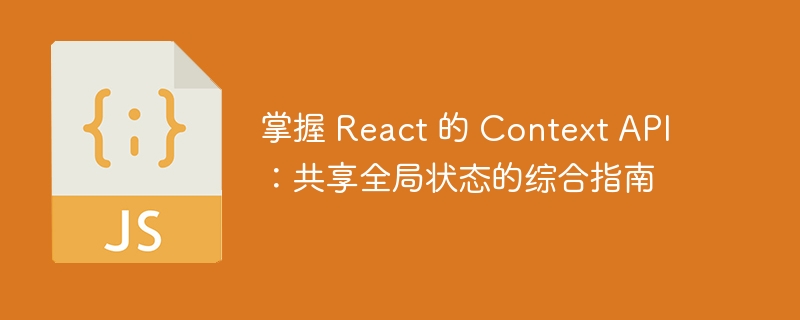掌握 React 的 Context API:共享全局状态的综合指南
时间:2025-01-14 09:45:30 485浏览 收藏
本篇文章给大家分享《掌握 React 的 Context API:共享全局状态的综合指南》,覆盖了文章的常见基础知识,其实一个语言的全部知识点一篇文章是不可能说完的,但希望通过这些问题,让读者对自己的掌握程度有一定的认识(B 数),从而弥补自己的不足,更好的掌握它。

React Context API:跨组件高效共享数据
React 的 Context API 提供了一种在组件间共享数据的高效机制,无需层层传递 props,尤其适用于管理全局状态,例如主题、认证信息或用户偏好设置。
1. Context API 简介
Context API 创建了一种全局状态,无论组件嵌套深度如何,任何组件都能访问。这避免了繁琐的 prop-drilling,使代码更简洁易维护。
2. Context API 工作原理
Context API 主要包含三个部分:
React.createContext():创建一个包含共享值的 Context 对象。Context.Provider:向组件树提供 Context 值。Context.Consumer或useContext钩子:用于访问 Context 值。
3. 创建和使用 Context
首先,用 React.createContext() 创建 Context。此函数返回一个对象,包含 Provider 和 Consumer。
示例:创建和使用 Context
import React, { createContext, useState, useContext } from 'react';
const AuthContext = createContext();
const AuthProvider = ({ children }) => {
const [user, setUser] = useState(null);
const login = (userName) => setUser({ name: userName });
const logout = () => setUser(null);
return (
<AuthContext.Provider value={{ user, login, logout }}>
{children}
</AuthContext.Provider>
);
};
const Profile = () => {
const { user, logout } = useContext(AuthContext);
return user ? (
<div>
<p>欢迎,{user.name}!</p>
<button onClick={logout}>登出</button>
</div>
) : (
<p>请登录。</p>
);
};
const App = () => {
const { login } = useContext(AuthContext);
return (
<AuthProvider>
<button onClick={() => login('John Doe')}>登录</button>
<Profile />
</AuthProvider>
);
};
export default App;
7. 结论
Context API 是 React 中强大的状态管理工具,简化了状态管理,避免了 prop-drilling,方便管理全局数据,例如认证、主题或语言设置。 createContext()、Provider 和 useContext() 组合使用,能高效且易维护地传递数据。
以上就是《掌握 React 的 Context API:共享全局状态的综合指南》的详细内容,更多关于的资料请关注golang学习网公众号!
-
502 收藏
-
501 收藏
-
501 收藏
-
501 收藏
-
501 收藏
-
220 收藏
-
102 收藏
-
420 收藏
-
498 收藏
-
278 收藏
-
156 收藏
-
225 收藏
-
250 收藏
-
446 收藏
-
228 收藏
-
360 收藏
-
165 收藏
-

- 前端进阶之JavaScript设计模式
- 设计模式是开发人员在软件开发过程中面临一般问题时的解决方案,代表了最佳的实践。本课程的主打内容包括JS常见设计模式以及具体应用场景,打造一站式知识长龙服务,适合有JS基础的同学学习。
- 立即学习 543次学习
-

- GO语言核心编程课程
- 本课程采用真实案例,全面具体可落地,从理论到实践,一步一步将GO核心编程技术、编程思想、底层实现融会贯通,使学习者贴近时代脉搏,做IT互联网时代的弄潮儿。
- 立即学习 516次学习
-

- 简单聊聊mysql8与网络通信
- 如有问题加微信:Le-studyg;在课程中,我们将首先介绍MySQL8的新特性,包括性能优化、安全增强、新数据类型等,帮助学生快速熟悉MySQL8的最新功能。接着,我们将深入解析MySQL的网络通信机制,包括协议、连接管理、数据传输等,让
- 立即学习 500次学习
-

- JavaScript正则表达式基础与实战
- 在任何一门编程语言中,正则表达式,都是一项重要的知识,它提供了高效的字符串匹配与捕获机制,可以极大的简化程序设计。
- 立即学习 487次学习
-

- 从零制作响应式网站—Grid布局
- 本系列教程将展示从零制作一个假想的网络科技公司官网,分为导航,轮播,关于我们,成功案例,服务流程,团队介绍,数据部分,公司动态,底部信息等内容区块。网站整体采用CSSGrid布局,支持响应式,有流畅过渡和展现动画。
- 立即学习 485次学习
